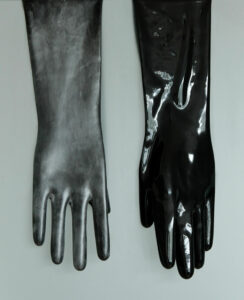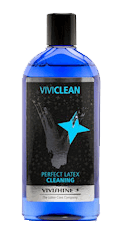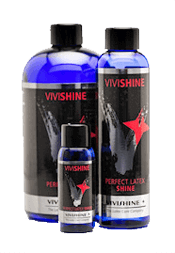Latex is a natural product (=natural rubber) and proper care is crucial to how long you will enjoy your garment.
Latex ages and is fragile – however, with proper latex care using high quality products, you can ensure that your latex lasts a long time.
Incorrect latex care - possible damage:
Unfortunately, it happens again and again that the latex is not properly maintained. The result is that the latex ages faster or even latex cancer develops. In latex cancer, the latex first becomes wavy, then completely soft, brittle and breaks – impossible to repair.
Often the wrong care product is used because there is nothing suitable at hand or because you want to save money. Here, savings should not be made at the wrong end. Particular care should be taken with various oils, e.g. baby oil, skin cream or grease, as these penetrate the material and break it down.
What is better for the care of latex: powder or oil?
 Admittedly, the question cannot be answered unequivocally.
Admittedly, the question cannot be answered unequivocally.
The fact is that either powder or a suitable oil such as ViviShine is needed to prevent the material from sticking together.
When new and during processing, latex is always powdered. This can be easily wiped off where glue is to be applied, so that the glue can hold. This is not possible with oil. Some people like the powdery look, which looks a bit like the tubes of tires. However, a glossy look is much more appealing to most people. This means that, as a rule, no powder is desired for the treatment of the visible outer surface.
You can, of course, powder the inside and apply oil on the outside for shine if you prefer powder on your skin. However, some are allergic to powder or it itches. And when you sweat a white sauce is created – oil seems to be the better choice for the most part.
In any case, mix powder and oil is crap! Because no matter how much oil is used, it will not create a beautiful shine if it combines with the powder underneath to form a lubricating film. So, for example, a new powdered garment first thoroughly wash off the powder and then leave in VIVISHINE.
On the other hand, as preparation for repairs (return or gluing), thorough washing and subsequent powdering is recommended. This can also be a good solution for longer storage in a compressed state (e.g. suitcase). For such cases we can recommend, for example, talcum powder from Optimal Products.
Step by step: care for latex properly
1) Clean latex and wash properly
Should you wash the latex after each wear?
After each wear, a few lint or dust remain on the surface and on the inside particles from the skin e.g. sweat, skin grease etc.. If this is not cleaned, it can soak into the latex in the long term, damage and also reduce the shine from the outside.
Therefore, we always recommend at least a short wash after each wear.
Wash best by hand:

It is best to clean the latex clothing by hand. To do this, add a little ViviCLEAN (approx. 15-20ml) to lukewarm water (approx. 30-40°C).
Turn the latex in it for at least 1 minute and then rinse it thoroughly with clean water.
In case of very heavy soiling or odors, the latex can also be soaked in ViviCLEAN for longer (approx. 30 minutes) to achieve maximum cleaning and hygiene effect.
2) Provide latex with perfect gloss
 If theLatex is to be kept shiny and ready for immediate use, the garment should be covered with a protective layer.
If theLatex is to be kept shiny and ready for immediate use, the garment should be covered with a protective layer.
After washing, pour in fresh clear water and add (about 1 tablespoon) ViviSHINE. Let the latex clothing bathe in it for a few minutes and move it around a bit so that all areas are evenly wetted.
Then briefly shake off the latex and hang for a few hours to dry and air out. Especially if the water contains lime, it is recommended to dab the water drops with a towel. Ready is the perfect gloss.
White spots on the latex?!

Latex has osmotic properties. This means that although it does not allow water or other liquids to pass through, it does absorb some of them in the material. This is reversible, so only for a certain time until it dries up again.
These inclusions of water and the like can lead to discoloration or light spots in the material that look milky and cloudy. Especially with transparent latex it is good to observe that some areas turn milky when worn or washed. color. Even black or colored latex can appear gray or pale. But as I said, this is a temporary phenomenon.
After drying, there is nothing more to see of it. However, this s drying out may take several hours or even a day
3) Store latex properly
Latex is sensitive to other materials and light. In order not to damage the latex, it must be stored properly. The best place is a light-protected area, e.g. in the cabinet. Be careful not to touch other colors or materials, as they can cause discoloration.
Clothes bags or plastic bags are well suited. When using garment bags, pay attention to the material, especially the hangers, so that they do not damage the latex clothing. Any plasticizers can also be absorbed into the latex and ensure a faster aging process.
Discoloration due to metal:
Latex reacts in combination with moisture, possibly salt and especially non-ferrous metals (brass, copper, gold, nickel…) and can discolor unsightly. Usually these discolorations are yellow to brown and very unpleasant, especially with light-colored latex.
The only measure against it is prevention. So be especially careful with latex and jewelry or piercings, for example. If in doubt, it is better to omit or remove something before discoloration occurs.

